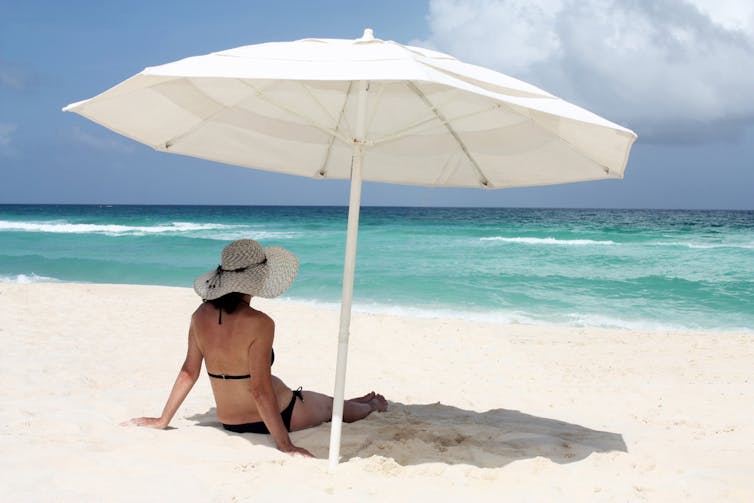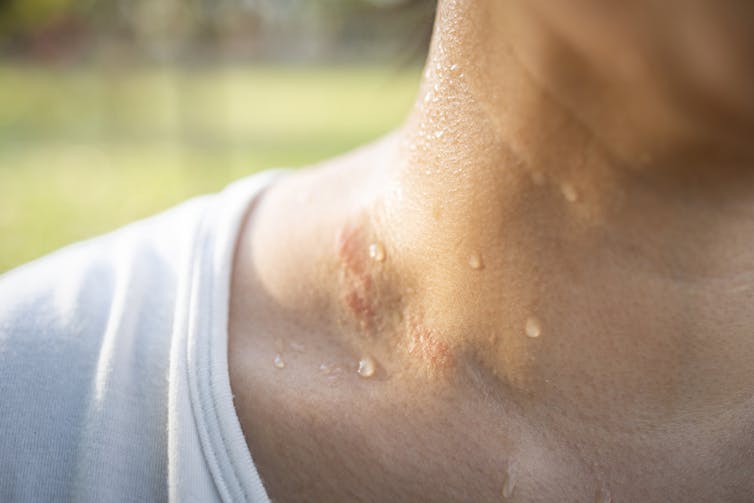I can't get sunburnt through glass, shade or in water, right? 5 common sunburn myths busted
- Written by Elke Hacker, Research Fellow, Queensland University of Technology
Despite decades of public health campaigns, skin cancer remains a major threat to health in Australia, with more cases diagnosed each year than all other cancers combined.
Skin cancer rates remain high and sunburn is all too common in Australia.
Our research looks at how best to inform people about the hazards of ultraviolet (UV) radiation, including by evaluating and testing shade, as well as the development of wearable UV indicators including stickers and wristbands. While this technology can help to improve people’s sun protection habits, we continue to come up against some common myths about sunburn.
As we’re in the middle of summer, it seems a good time to debunk some of these.
Myth 1: “You can’t get burnt in the shade”
Effective shade can provide protection from the Sun’s UV rays, but we can still get burnt in the shade.
Shade materials with holes or gaps can allow penetration by UV radiation.
The same rule applies for tree shade, with denser foliage and wider canopies providing better protection than trees with sparse foliage and dappled sunlight.
Similarly, solid roof structures with wide overhangs and little sky view provide greater UV radiation protection than smaller structures.
Reflected UV radiation is another factor that means you’re not always safe in the shade. The Sun’s rays reflect from light-coloured surfaces and can bounce back under shade.
Light surfaces, such as concrete, light-coloured paint or metallic surfaces, reflect more than dark ones. Sand can reflect as much as 25% of UV radiation. This means if you’re sitting under a beach umbrella, UV radiation can still damage your skin, even though you feel like you’re covered in the shade.
 Sand reflects up to 25% of UV radiation.
Shutterstock
Sand reflects up to 25% of UV radiation.
Shutterstock
Myth 2: “You’re safe from the sun when in water”
Up to 40% of total UV radiation hits the body even half a metre below the surface of the water, according to SunSmart.
Ordinarily, you would have to dive at least 2.5m inshore and 4.5m in offshore coastal waters to avoid harmful UV radiation. This is because offshore waters tend to be clearer, so UV can penetrate further, whereas inshore waters tend to have sediment and nutrients that can cause a rapid decline in UV.
When swimming, you may not notice when your skin is burning due to the cooling effect of water. Reflective surfaces around water environments can also amplify UV, such as concrete or other hard surfaces around a swimming pool.
The importance of adequate sun protection when participating in water-based activities is highlighted by the rate of sunburn in Queenslanders, with 45% of children sunburnt in the previous 12 months and 69% of these sunburns acquired during a water-based activity.
Myth 3: “Exercise makes my skin red hot, not the sun”
You might often hear people say, when they return from exercise, that they’re red only because they’ve been running. While this does occur, redness from exercise usually dissipates quickly — so if you’re still red in the 24 hours after exercise, it’s sunburn.
When you exercise, your body temperature increases and your body’s natural mechanism is to cool down by carrying blood towards the skin’s surface, causing one to sweat and cool off.
Sweat washes sunscreen away and towelling down wipes off sunscreen.
Regular reapplication of a water-resistant sunscreen is vital. Work-out tan lines are signs of skin damage. Each time our skin gets damaged we greatly increase our risk for skin cancer.
 Sweat can wash sunscreen away. If you don’t reapply regularly, you risk skin damage.
Shutterstock
Sweat can wash sunscreen away. If you don’t reapply regularly, you risk skin damage.
Shutterstock
Myth 4: “That’s not sunburn, it’s windburn”
Windburn can make your skin red, but in Australia, windburn is pretty rare. It’s more likely to occur in instances like skiing, by very windy, cold and dry conditions, with dense mountain clouds and minimal or no sunlight. In Australia, it’s much more likely to be sunburn.
What’s more, high winds can actually increase the likelihood of getting sunburn. Wind dries out and weakens the outer layer of skin. Wind force can make these dead skin cells fall off.
When you apply sunscreen, it coats this outer layer of skin. As wind brushes these skin cells away your sunscreen goes with it, leaving unprotected skin to be burnt by the sun.
Using sun-protective clothing and reapplying sunscreen are the best ways to avoid skin damage when it’s windy.
Myth 5: “You can’t get burnt in the car through a window”
Often, glass used in car side windows is untinted. It reduces UV radiation but doesn’t completely block transmission.
This means you can still get skin damage if you spend a long time in the car next to an untinted side window. Tinted windows can help reduce the amount of UV that hits your skin, and the rule of thumb is that the darker the tint, the more it protects — it’s worth noting, though, that legally you can’t tint your whole front window in Australia, which is obviously the biggest window in the car.
More commonly, however, people are sunburnt in cars when they have the side windows down and are exposed to a short period of high levels of UV radiation.
 It is possible to get sunburnt with the windows up in a car. But it’s more common to get burnt when you’ve wound down the windows.
Shutterstock
It is possible to get sunburnt with the windows up in a car. But it’s more common to get burnt when you’ve wound down the windows.
Shutterstock
Simple solutions are the five sun-safe measures — slip, slop, slap, seek, slide:
slip on a long-sleeved shirt. If you’re in water, this might include a rashie or wetsuit.
slop on an SPF 30 or higher sunscreen, and reapply at least every two hours, or sooner after swimming or sweating
slap on a broad-brimmed hat
seek shade
slide on sunnies.
Authors: Elke Hacker, Research Fellow, Queensland University of Technology





